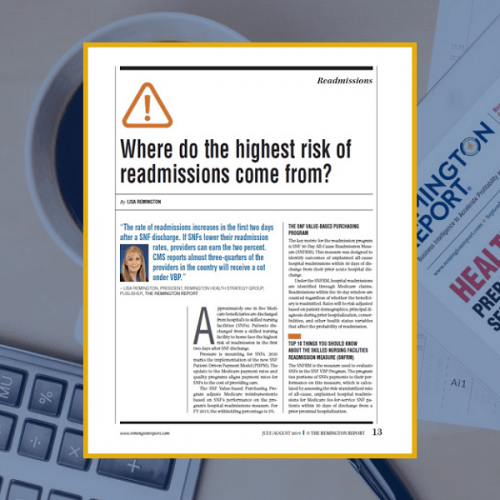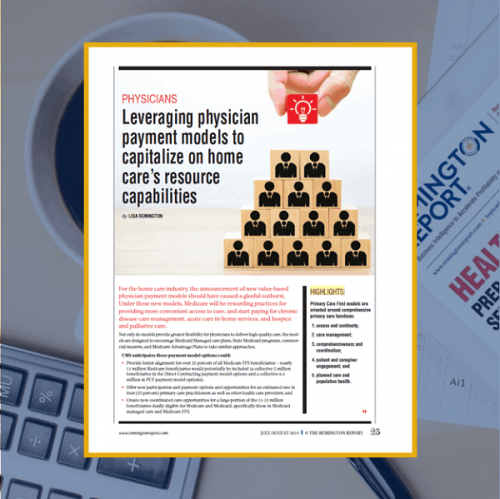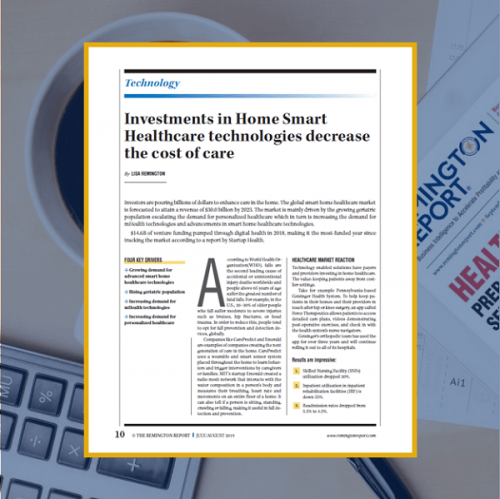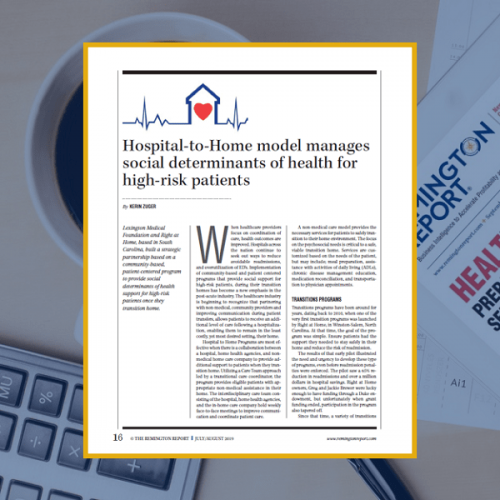-
 Telehealth is predicted to be the next big investment for seniors aging in place. The number of seniors requiring additional caregiving and support due to chronic disease will increase from about 14 percent of the senior population in 2010 to 21 percent by 2050, putting the pressure on healthcare providers to improve caregiving platforms. This article is free to 1-Year Classic and 2-Year Premium subscribers.
Telehealth is predicted to be the next big investment for seniors aging in place. The number of seniors requiring additional caregiving and support due to chronic disease will increase from about 14 percent of the senior population in 2010 to 21 percent by 2050, putting the pressure on healthcare providers to improve caregiving platforms. This article is free to 1-Year Classic and 2-Year Premium subscribers. -
 Aggressive moves by payers teaming up with big players such as CVS are advancing their healthcare programs into the home. How does this impact healthcare organizations? Are these new partnering opportunities or, a new competitor on the horizon? This article is free to 1-Year Classic and 2-Year Premium subscribers.
Aggressive moves by payers teaming up with big players such as CVS are advancing their healthcare programs into the home. How does this impact healthcare organizations? Are these new partnering opportunities or, a new competitor on the horizon? This article is free to 1-Year Classic and 2-Year Premium subscribers. -
 The Centers for Medicare & Medicaid Innovation (CMMI) recently announced five new payment models transforming?kidney care so that patients?with chronic kidney disease have access to high quality, coordinated care. The payment models are in response to an executive order signed by President Trump on advancing kidney health. This article is free to 1-Year Classic and 2-Year Premium subscribers.
The Centers for Medicare & Medicaid Innovation (CMMI) recently announced five new payment models transforming?kidney care so that patients?with chronic kidney disease have access to high quality, coordinated care. The payment models are in response to an executive order signed by President Trump on advancing kidney health. This article is free to 1-Year Classic and 2-Year Premium subscribers. -
 About two-thirds of hospital readmission costs were higher than their initial admission costs for common diagnoses in 2016, according to a Healthcare Cost and Utilization Project Statistical Brief released by the Agency for Healthcare Research and Quality. This article is free to 1-Year Classic and 2-Year Premium subscribers.
About two-thirds of hospital readmission costs were higher than their initial admission costs for common diagnoses in 2016, according to a Healthcare Cost and Utilization Project Statistical Brief released by the Agency for Healthcare Research and Quality. This article is free to 1-Year Classic and 2-Year Premium subscribers. -
 This is the second article in series to discuss how to promote the growth of in-home community-based organizations and accelerate relationships with payers. The first article published in The Remington Report's July/August issue, pages 4-8, focused on the home health aide workforce: How Real Time Actionable Data Leverages New Value For Home Health Aides and Stakeholders. This article is free to 1-Year Classic and 2-Year Premium subscribers.
This is the second article in series to discuss how to promote the growth of in-home community-based organizations and accelerate relationships with payers. The first article published in The Remington Report's July/August issue, pages 4-8, focused on the home health aide workforce: How Real Time Actionable Data Leverages New Value For Home Health Aides and Stakeholders. This article is free to 1-Year Classic and 2-Year Premium subscribers. -
 Adam Boehler left his position as the deputy administrator and director of CMS and Medicaid Innovation (CMMI). His position at CMMI was important to home and community-based providers. His work created models to pay primary care physicians based on value, tie prices of drugs administered in a doctor's office to the amount other countries pay, and a drive to move?more people to get dialysis in their homes. This article is free to 1-Year Classic and 2-Year Premium subscribers.
Adam Boehler left his position as the deputy administrator and director of CMS and Medicaid Innovation (CMMI). His position at CMMI was important to home and community-based providers. His work created models to pay primary care physicians based on value, tie prices of drugs administered in a doctor's office to the amount other countries pay, and a drive to move?more people to get dialysis in their homes. This article is free to 1-Year Classic and 2-Year Premium subscribers. -
 The Office of Inspector General (OIG) of the U.S. Department of Health and Human Services (HHS), the primary enforcer of fraud and abuse prohibitions, has issued its annual recommendations that, if implemented, will likely affect HHS programs positively in terms of cost savings, program effectiveness and efficiency, and public health and safety. This article is free to 1-Year Classic and 2-Year Premium subscribers.
The Office of Inspector General (OIG) of the U.S. Department of Health and Human Services (HHS), the primary enforcer of fraud and abuse prohibitions, has issued its annual recommendations that, if implemented, will likely affect HHS programs positively in terms of cost savings, program effectiveness and efficiency, and public health and safety. This article is free to 1-Year Classic and 2-Year Premium subscribers. -
 The first two years of the Comprehensive Care for Joint Replacement (CJR) saved Medicare more than?$1,00 per episode. CJR, a five-year Medicare program rolled out in 2016, pays participating?hospitals for hip and knee replacements by episode of care: from admission to 90 days post discharge. This article is free to 1-Year Classic and 2-Year Premium subscribers.
The first two years of the Comprehensive Care for Joint Replacement (CJR) saved Medicare more than?$1,00 per episode. CJR, a five-year Medicare program rolled out in 2016, pays participating?hospitals for hip and knee replacements by episode of care: from admission to 90 days post discharge. This article is free to 1-Year Classic and 2-Year Premium subscribers. -
 The rate of readmissions increases in the first two days after a SNF discharge. If SNFs lower their readmission rates, providers can earn the two percent. CMS reports almost three-quarters of the providers in the country will receive a cut under VBP. This article is free to 1-Year Classic and 2-Year Premium subscribers.
The rate of readmissions increases in the first two days after a SNF discharge. If SNFs lower their readmission rates, providers can earn the two percent. CMS reports almost three-quarters of the providers in the country will receive a cut under VBP. This article is free to 1-Year Classic and 2-Year Premium subscribers. -
 For the home care industry, the announcement of new value-based physician payment models should have caused a gleeful outburst. Under these new models, Medicare will be rewarding practices for providing more convenient access to care, and start paying for chronic disease care management, acute care in-home services, and hospice and palliative care. This article is free to 1-Year Classic and 2-Year Premium subscribers.
For the home care industry, the announcement of new value-based physician payment models should have caused a gleeful outburst. Under these new models, Medicare will be rewarding practices for providing more convenient access to care, and start paying for chronic disease care management, acute care in-home services, and hospice and palliative care. This article is free to 1-Year Classic and 2-Year Premium subscribers. -
 Investors are pouring billions of dollars to enhance care in the home. The global smart home healthcare market is forecasted to attain a revenue of $30.0 billion by 2023. The market is mainly driven by the growing geriatric population escalating the demand for personalized healthcare which in turn is increasing the demand for mHealth technologies and advancements in smart home healthcare technologies. This article is free to 1-Year Classic and 2-Year Premium subscribers.
Investors are pouring billions of dollars to enhance care in the home. The global smart home healthcare market is forecasted to attain a revenue of $30.0 billion by 2023. The market is mainly driven by the growing geriatric population escalating the demand for personalized healthcare which in turn is increasing the demand for mHealth technologies and advancements in smart home healthcare technologies. This article is free to 1-Year Classic and 2-Year Premium subscribers. -
 Lexington Medical Foundation and Right at Home, based in South Carolina, built a strategic partnership based on a community-based, patient-centered program to provide social determinants of health support for high-risk patients once they transition home. This article is free to 1-Year Classic and 2-Year Premium subscribers.
Lexington Medical Foundation and Right at Home, based in South Carolina, built a strategic partnership based on a community-based, patient-centered program to provide social determinants of health support for high-risk patients once they transition home. This article is free to 1-Year Classic and 2-Year Premium subscribers.







